engine Citroen JUMPY MULTISPACE DAG 2010 2.G Owner's Manual
[x] Cancel search | Manufacturer: CITROEN, Model Year: 2010, Model line: JUMPY MULTISPACE DAG, Model: Citroen JUMPY MULTISPACE DAG 2010 2.GPages: 235, PDF Size: 11.17 MB
Page 3 of 235

6
7
6
6
7
Exterior
FAMILIARISATION
1
Opening the bonnet 107
Diesel engines Petrol engine
108
134
Towing eye 106
Partially open the bonnet, lift the control and
raise the bonnet.
Secure the strut in one of the two notches,
according to the height required, to hold the
bonnet open.
Lift the cover at the foot of the left-hand
seat and pull the control upwards.
At the front, unclip the cover by pressing it
at the bottom.
At the rear, unclip the cover using a coin or
the flat part of the towing eye. Take care when working under the bonnet.
Refer to the "Levels" section of chapter 6 for adv
ice on use of the fluids.
Page 14 of 235

Access
KEY
This locks and unlocks the locks on the
vehicle and starts the engine.
REMOTE CONTROL
ELECTRONIC IMMOBILISER
All of the keys contain an electronic
immobiliser device.
This device locks the engine supply system.
It is activated automatically when the key is
removed from the ignition.
After the ignition is switched on, a dialogue
is established between the key and the
electronic immobiliser system.
The metal part of the key must be unfolded
correctly for correct dialogue to take place.
Programming the remote control
Following changing of the remote control battery
or disconnection of the vehicle battery, the
remote control may have to be reprogrammed.
Wait at least one minute before using the
remote control.
Insert the key in the ignition switch with the
buttons (padlocks) of the remote control
facing you. Switch on the ignition.
Press the locking padlock for at least five
seconds within the next ten seconds.
Switch off the ignition.
Wait at least one minute before using the
remote control.
The remote control is now working again.
There is a risk of damage if the replacement
battery does not conform.
Use only identical batteries or batteries of an
equivalent type to those recommended by
CITROËN dealers.
Do not discard the remote control batteries,
they contain metals which are harmful to the
environment.
Deposit them at a CITROËN dealership, or
at any other approved collection point.
Changing the battery
Battery ref.: CR1620/3 volts.
The information "battery flat" is given by an
audible signal, accompanied by a message
on the display.
To replace the battery, unclip the casing
using a coin at the ring.
If the remote control does not work after the
battery has been changed, re-programme
the remote control. If you lose your keys
Visit a CITROËN dealer with the
vehicle's V5 registration document and
your identification document.
A CITROËN dealer will be able to retrieve
the key code and the transponder code so
that a replacement key can be ordered.
Page 16 of 235

Access
KEY
This locks and unlocks the locks on the
vehicle and starts the engine.
REMOTE CONTROL
ELECTRONIC IMMOBILISER
All of the keys contain an electronic
immobiliser device.
This device locks the engine supply system.
It is activated automatically when the key is
removed from the ignition.
After the ignition is switched on, a dialogue
is established between the key and the
electronic immobiliser system.
The metal part of the key must be unfolded
correctly for correct dialogue to take place.
Programming the remote control
Following changing of the remote control battery
or disconnection of the vehicle battery, the
remote control may have to be reprogrammed.
Wait at least one minute before using the
remote control.
Insert the key in the ignition switch with the
buttons (padlocks) of the remote control
facing you. Switch on the ignition.
Press the locking padlock for at least five
seconds within the next ten seconds.
Switch off the ignition.
Wait at least one minute before using the
remote control.
The remote control is now working again.
There is a risk of damage if the replacement
battery does not conform.
Use only identical batteries or batteries of an
equivalent type to those recommended by
CITROËN dealers.
Do not discard the remote control batteries,
they contain metals which are harmful to the
environment.
Deposit them at a CITROËN dealership, or
at any other approved collection point.
Changing the battery
Battery ref.: CR1620/3 volts.
The information "battery flat" is given by an
audible signal, accompanied by a message
on the display.
To replace the battery, unclip the casing
using a coin at the ring.
If the remote control does not work after the
battery has been changed, re-programme
the remote control. If you lose your keys
Visit a CITROËN dealer with the
vehicle's V5 registration document and
your identification document.
A CITROËN dealer will be able to retrieve
the key code and the transponder code so
that a replacement key can be ordered.
Page 21 of 235
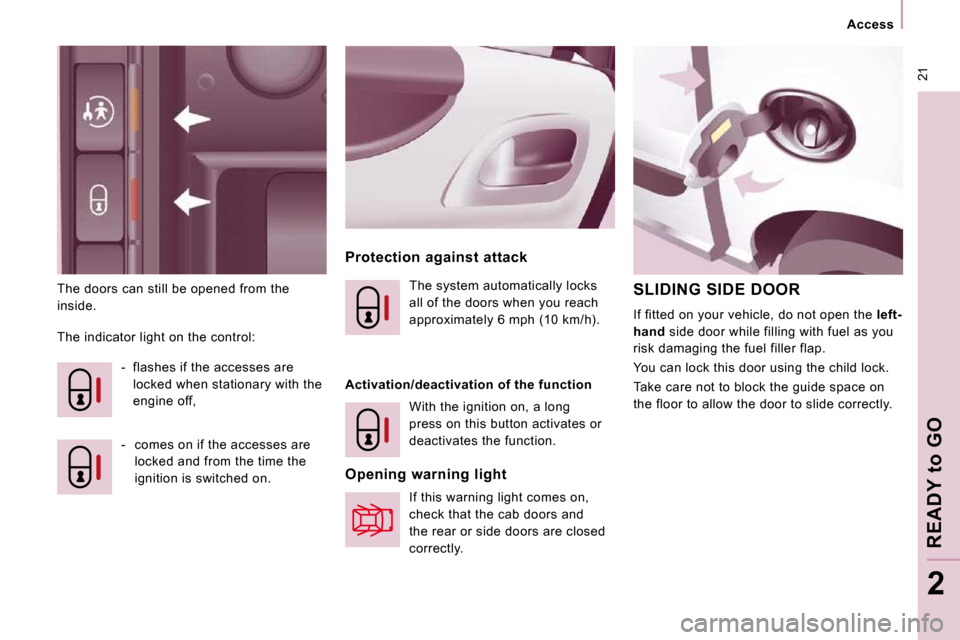
21
Access
READY
to
GO
2
The doors can still be opened from the
inside. Protection against attack
The indicator light on the control: - flashes if the accesses are locked when stationary with the
engine off,
- comes on if the accesses are locked and from the time the
ignition is switched on. The system automatically locks
all of the doors when you reach
approximately 6 mph (10 km/h).
Activation/deactivation of the function With the ignition on, a long
press on this button activates or
deactivates the function.
Opening warning light If this warning light comes on,
check that the cab doors and
the rear or side doors are closed
correctly. SLIDING SIDE DOOR
If fitted on your vehicle, do not open the left-
hand side door while filling with fuel as you
risk damaging the fuel filler flap.
You can lock this door using the child lock.
Take care not to block the guide space on
the floor to allow the door to slide correctly.
Page 22 of 235
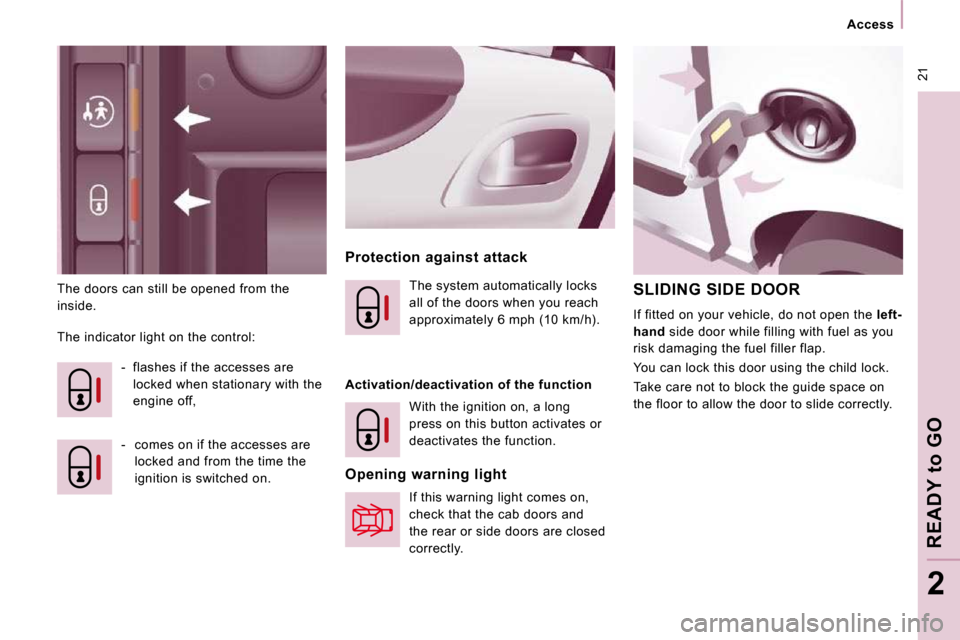
21
Access
READY
to
GO
2
The doors can still be opened from the
inside. Protection against attack
The indicator light on the control: - flashes if the accesses are locked when stationary with the
engine off,
- comes on if the accesses are locked and from the time the
ignition is switched on. The system automatically locks
all of the doors when you reach
approximately 6 mph (10 km/h).
Activation/deactivation of the function With the ignition on, a long
press on this button activates or
deactivates the function.
Opening warning light If this warning light comes on,
check that the cab doors and
the rear or side doors are closed
correctly. SLIDING SIDE DOOR
If fitted on your vehicle, do not open the left-
hand side door while filling with fuel as you
risk damaging the fuel filler flap.
You can lock this door using the child lock.
Take care not to block the guide space on
the floor to allow the door to slide correctly.
Page 25 of 235
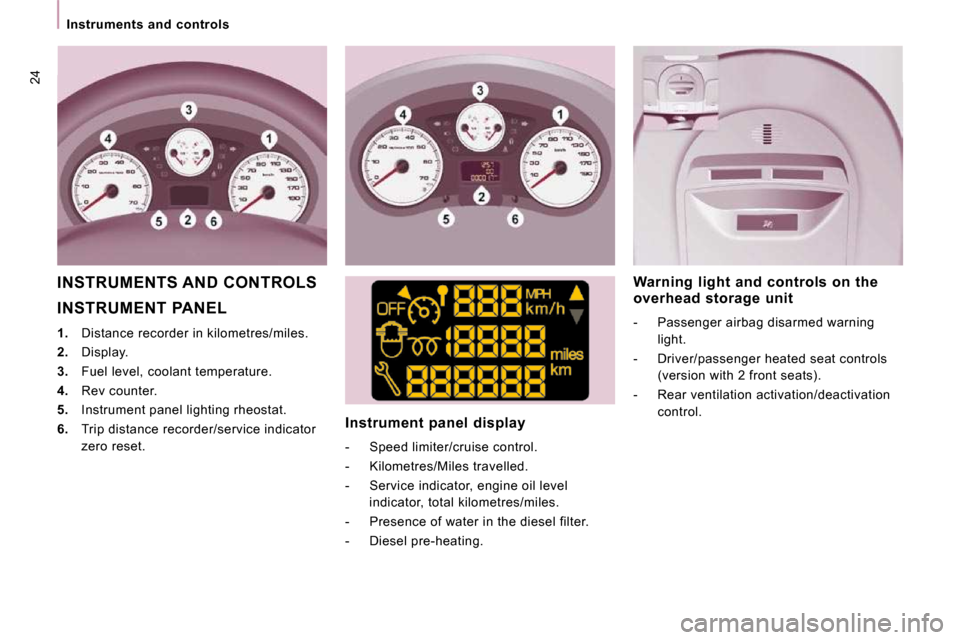
24
Instruments and controls
INSTRUMENT PANEL
1. Distance recorder in kilometres/miles.
2. Display.
3. Fuel level, coolant temperature.
4. Rev counter.
5. Instrument panel lighting rheostat.
6. Trip distance recorder/service indicator
zero reset. Instrument panel display
- Speed limiter/cruise control.
- Kilometres/Miles travelled.
- Service indicator, engine oil level
indicator, total kilometres/miles.
- Presence of water in the diesel filter.
- Diesel pre-heating. Warning light and controls on the
overhead storage unit
- Passenger airbag disarmed warning
light.
- Driver/passenger heated seat controls (version with 2 front seats).
- Rear ventilation activation/deactivation control.
INSTRUMENTS AND CONTROLS
Page 28 of 235
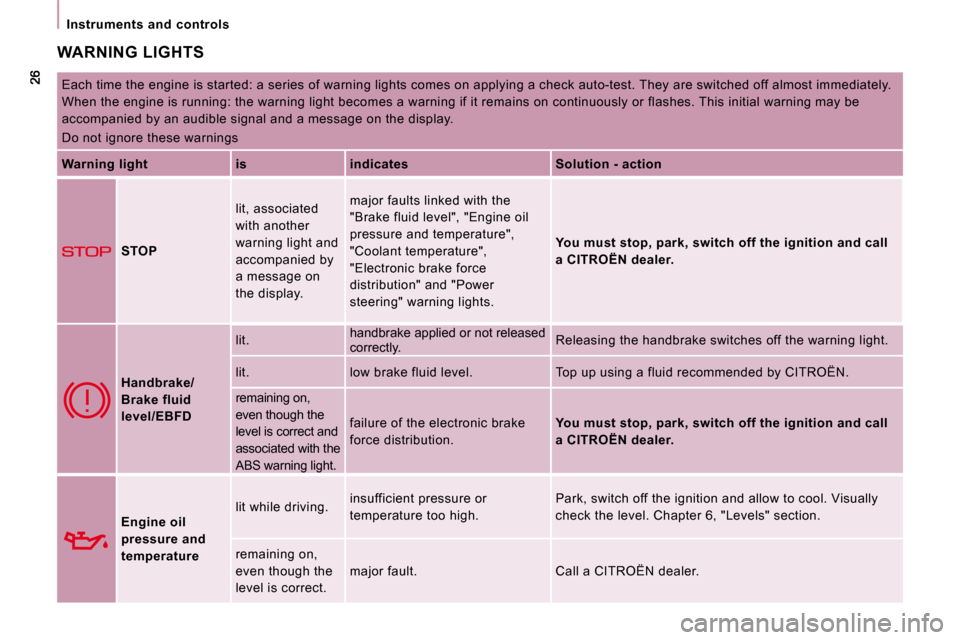
Instruments and controls
WARNING LIGHTS
Each time the engine is started: a series of warning lights comes on applying a check auto-test. They are switched off almost immediately.
When the engine is running: the warning light becom es a warning if it remains on continuously or flashes. This initial warning may be
accompanied by an audible signal and a message on t he display.
Do not ignore these warnings
Warning light is indicates Solution - action
STOP lit, associated
with another
warning light and
accompanied by
a message on
the display. major faults linked with the
"Brake fluid level", "Engine oil
pressure and temperature",
"Coolant temperature",
"Electronic brake force
distribution" and "Power
steering" warning lights.
You must stop, park, switch off the ignition and ca ll
a
CITROËN dealer.
Handbrake/
Brake fluid
level/EBFD lit.
handbrake applied or not released
correctly. Releasing the handbrake switches off the warning l
ight.
lit. low brake fluid level. Top up using a fluid recommended by CITROËN.
remaining on,
even though the
level is correct and
associated with the
ABS warning light. failure of the electronic brake
force distribution.
You must stop, park, switch off the ignition and ca ll
a CITROËN dealer.
Engine oil
pressure and
temperature lit while driving.
insufficient pressure or
temperature too high. Park, switch off the ignition and allow to cool. V
isually
check the level. Chapter 6, "Levels" section.
remaining on,
even though the
level is correct. major fault. Call a CITROËN dealer.
Page 34 of 235

32
Instruments and controls
FUEL GAUGE
The fuel level is tested each time the key is
turned to the "running" position.
The gauge is positioned on:
COOLANT TEMPERATURE
The needle is positioned before the red
zone: normal operation.
In arduous conditions of use or hot climatic
conditions, the needle may move close to
the red graduations.
What you should do if the warning light
comes on:
- stop immediately, switch off the ignition. The fan may continue to operate for
a certain time up to approximately
10 minutes,
- wait for the engine to cool down in order to check the coolant level and top it up if
necessary.
- 1: the fuel tank is full, approximately
80 litres.
- 0: the reserve is now being used, the
warning light comes on continuously.
The reserve when the warning first comes
on is approximately 8 litres.
Refer to the "Fuel" section of chapter 6.
What you should do if the needle enters
the red zone:
Reduce your speed or let the engine run at
idle. As the cooling system is pressurised, follow
this advice in order to avoid any risk of
scalding:
- wait at least one hour after switching off
the engine before carrying out any work,
- unscrew the cap by 1/4 turn to allow the pressure to drop,
- when the pressure has dropped, check the level on the expansion bottle,
- if necessary, remove the cap to top up.
If the needle remains in the red zone, have
the system checked by a CITROËN dealer.
Refer to the "Levels" section of chapter 6.
Page 35 of 235
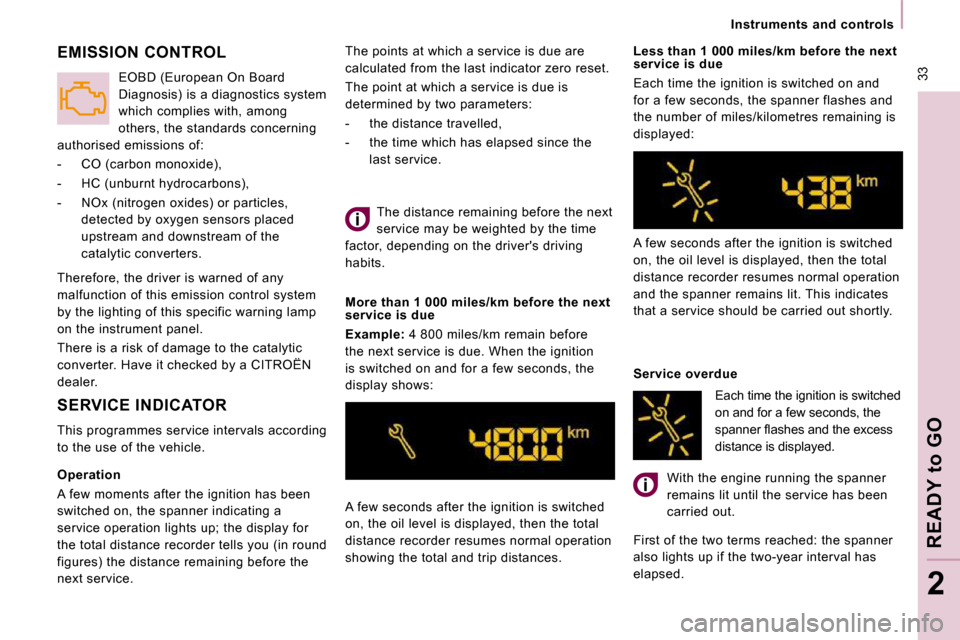
33
Instruments and controls
READY
to
GO
2
The points at which a service is due are
calculated from the last indicator zero reset.
The point at which a service is due is
determined by two parameters:
- the distance travelled,
- the time which has elapsed since the last service.
A few seconds after the ignition is switched
on, the oil level is displayed, then the total
distance recorder resumes normal operation
showing the total and trip distances. Less than 1 000 miles/km before the next
service is due
Each time the ignition is switched on and
for a few seconds, the spanner flashes and
the number of miles/kilometres remaining is
displayed:
A few seconds after the ignition is switched
on, the oil level is displayed, then the total
distance recorder resumes normal operation
and the spanner remains lit. This indicates
that a service should be carried out shortly.
Service overdue
With the engine running the spanner
remains lit until the service has been
carried out.
First of the two terms reached: the spanner
also lights up if the two-year interval has
elapsed.
The distance remaining before the next
service may be weighted by the time
factor, depending on the driver's driving
habits.
More than 1 000 miles/km before the next
service is due
Example: 4 800 miles/km remain before
the next service is due. When the ignition
is switched on and for a few seconds, the
display shows:
SERVICE INDICATOR
This programmes service intervals according
to the use of the vehicle.
EMISSION CONTROL
Therefore, the driver is warned of any
malfunction of this emission control system
by the lighting of this specific warning lamp
on the instrument panel.
There is a risk of damage to the catalytic
converter. Have it checked by a CITROËN
dealer. EOBD (European On Board
Diagnosis) is a diagnostics system
which complies with, among
others, the standards concerning
authorised emissions of:
- CO (carbon monoxide),
- HC (unburnt hydrocarbons),
- NOx (nitrogen oxides) or particles, detected by oxygen sensors placed
upstream and downstream of the
catalytic converters.
Each time the ignition is switched
on and for a few seconds, the
�s�p�a�n�n�e�r� �fl� �a�s�h�e�s� �a�n�d� �t�h�e� �e�x�c�e�s�s�
distance is displayed.
Operation
A few moments after the ignition has been
switched on, the spanner indicating a
service operation lights up; the display for
the total distance recorder tells you (in round
figures) the distance remaining before the
next service.
Page 36 of 235
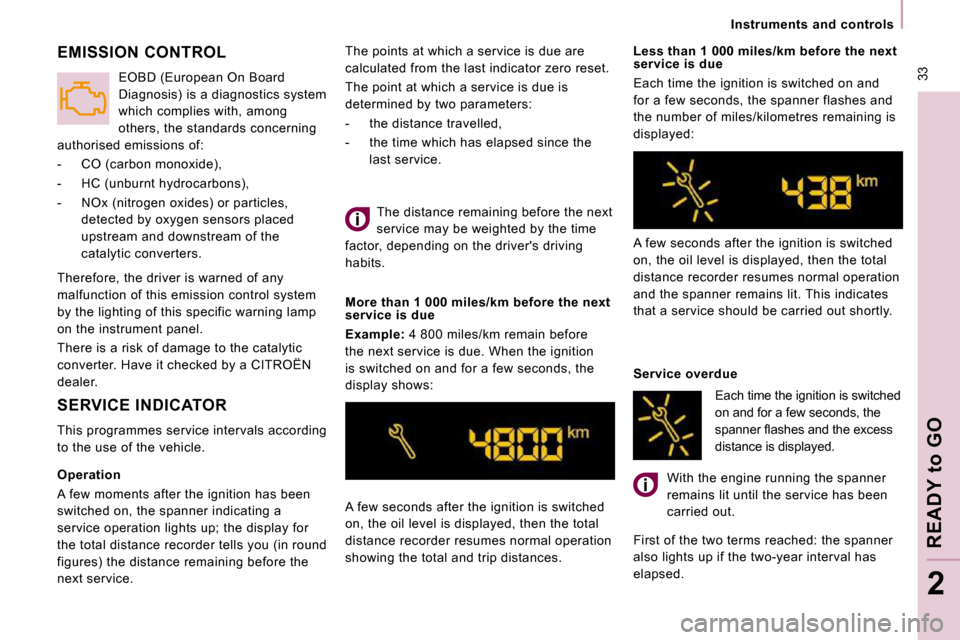
33
Instruments and controls
READY
to
GO
2
The points at which a service is due are
calculated from the last indicator zero reset.
The point at which a service is due is
determined by two parameters:
- the distance travelled,
- the time which has elapsed since the last service.
A few seconds after the ignition is switched
on, the oil level is displayed, then the total
distance recorder resumes normal operation
showing the total and trip distances. Less than 1 000 miles/km before the next
service is due
Each time the ignition is switched on and
for a few seconds, the spanner flashes and
the number of miles/kilometres remaining is
displayed:
A few seconds after the ignition is switched
on, the oil level is displayed, then the total
distance recorder resumes normal operation
and the spanner remains lit. This indicates
that a service should be carried out shortly.
Service overdue
With the engine running the spanner
remains lit until the service has been
carried out.
First of the two terms reached: the spanner
also lights up if the two-year interval has
elapsed.
The distance remaining before the next
service may be weighted by the time
factor, depending on the driver's driving
habits.
More than 1 000 miles/km before the next
service is due
Example: 4 800 miles/km remain before
the next service is due. When the ignition
is switched on and for a few seconds, the
display shows:
SERVICE INDICATOR
This programmes service intervals according
to the use of the vehicle.
EMISSION CONTROL
Therefore, the driver is warned of any
malfunction of this emission control system
by the lighting of this specific warning lamp
on the instrument panel.
There is a risk of damage to the catalytic
converter. Have it checked by a CITROËN
dealer. EOBD (European On Board
Diagnosis) is a diagnostics system
which complies with, among
others, the standards concerning
authorised emissions of:
- CO (carbon monoxide),
- HC (unburnt hydrocarbons),
- NOx (nitrogen oxides) or particles, detected by oxygen sensors placed
upstream and downstream of the
catalytic converters.
Each time the ignition is switched
on and for a few seconds, the
�s�p�a�n�n�e�r� �fl� �a�s�h�e�s� �a�n�d� �t�h�e� �e�x�c�e�s�s�
distance is displayed.
Operation
A few moments after the ignition has been
switched on, the spanner indicating a
service operation lights up; the display for
the total distance recorder tells you (in round
figures) the distance remaining before the
next service.